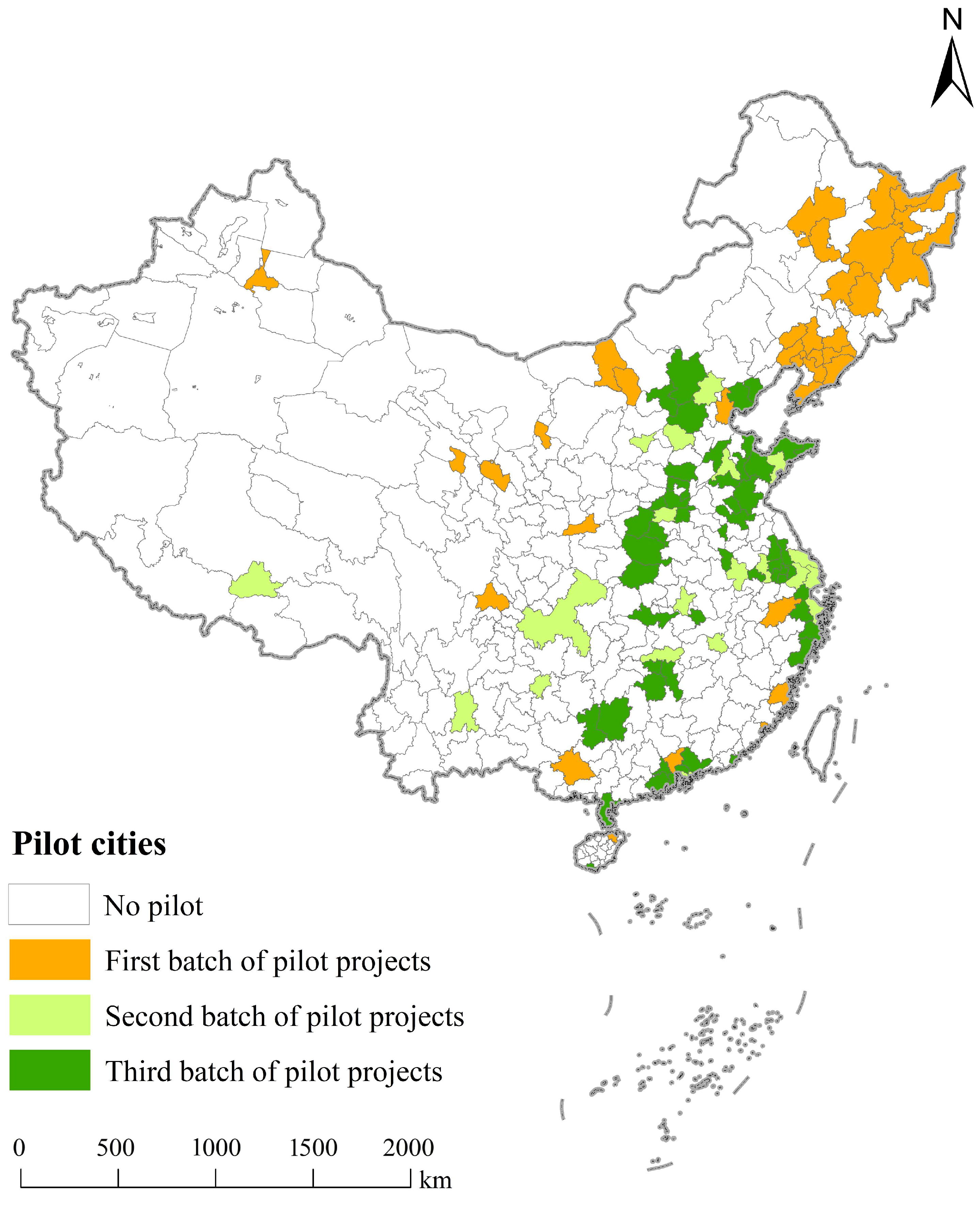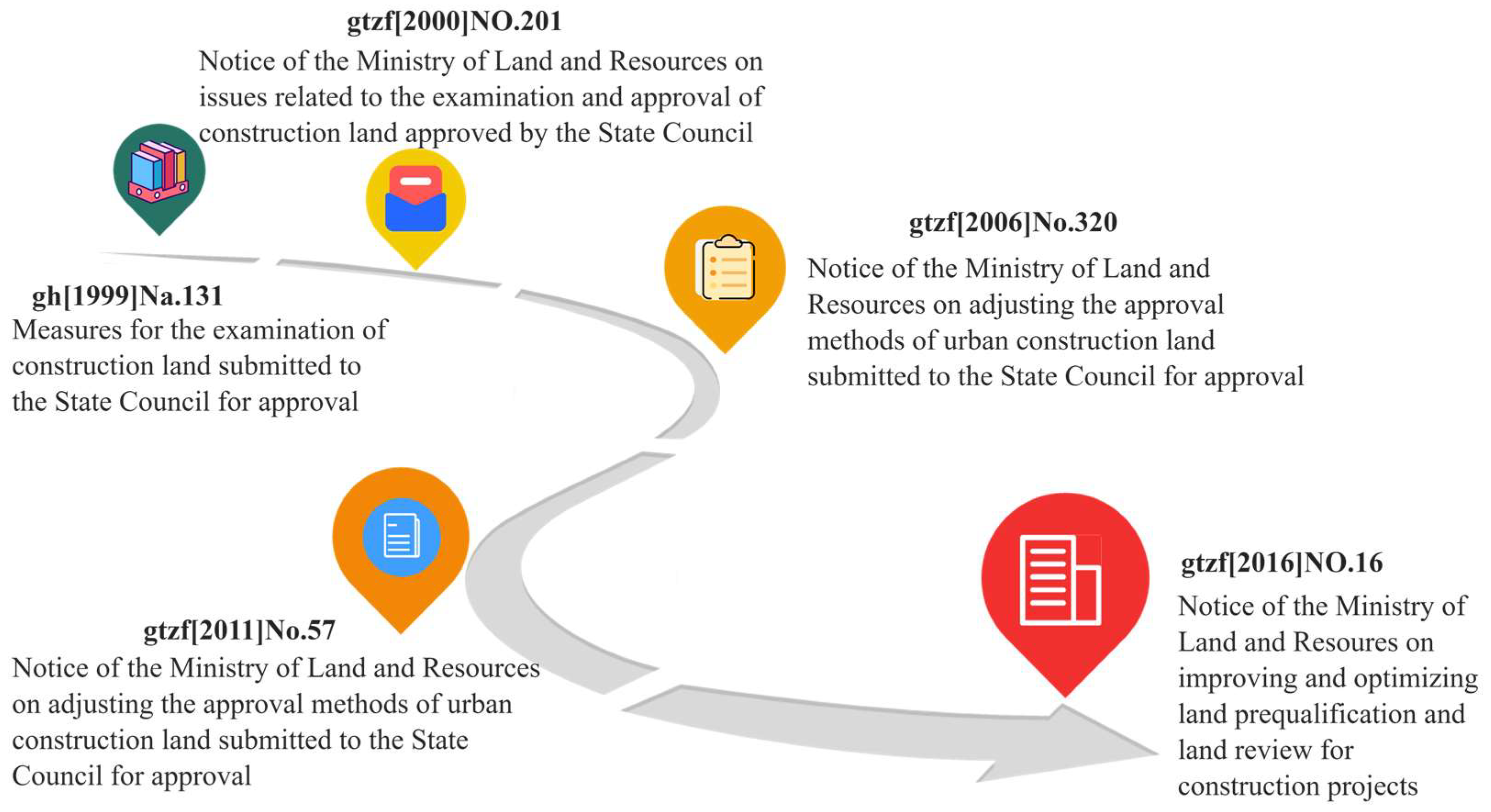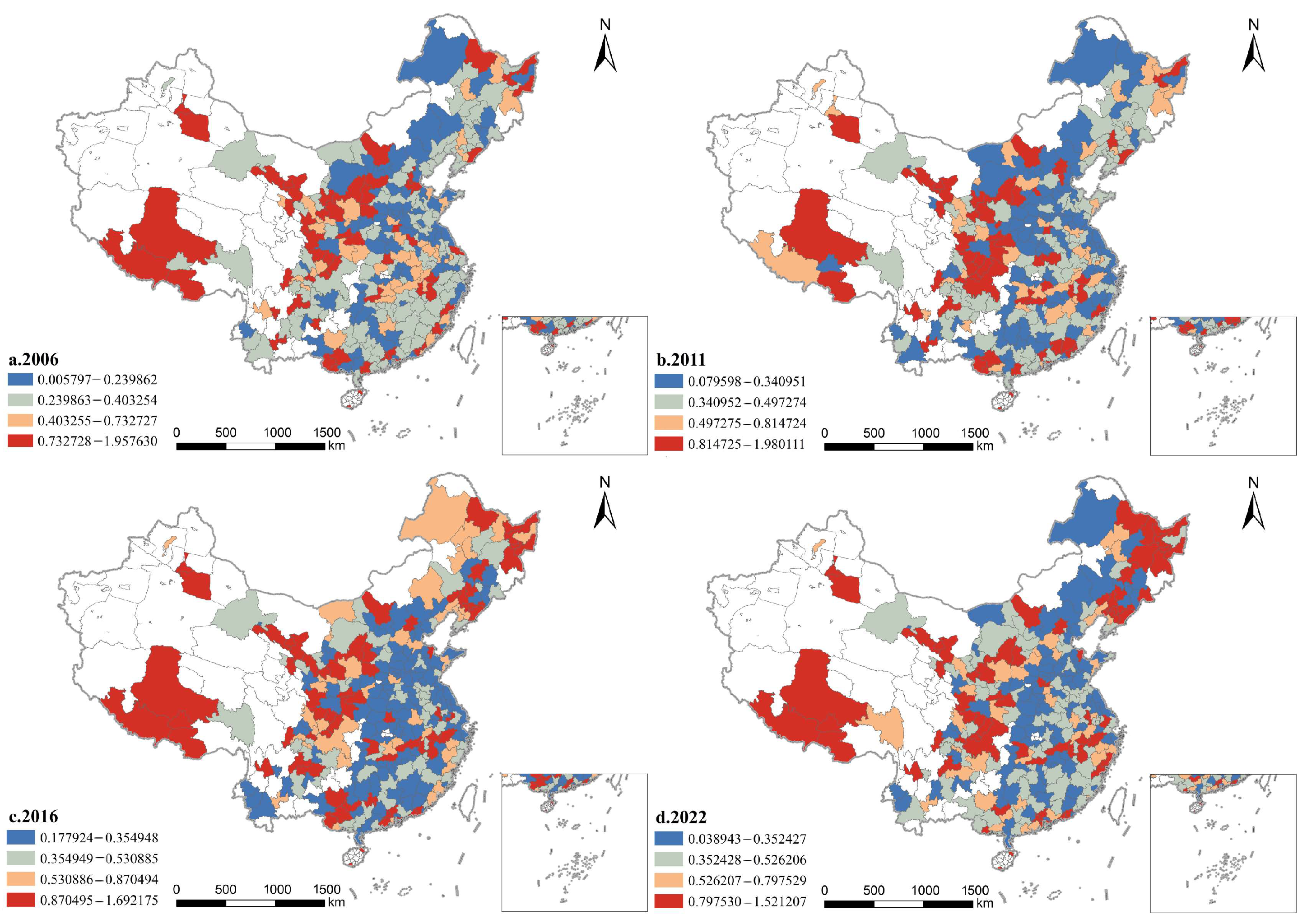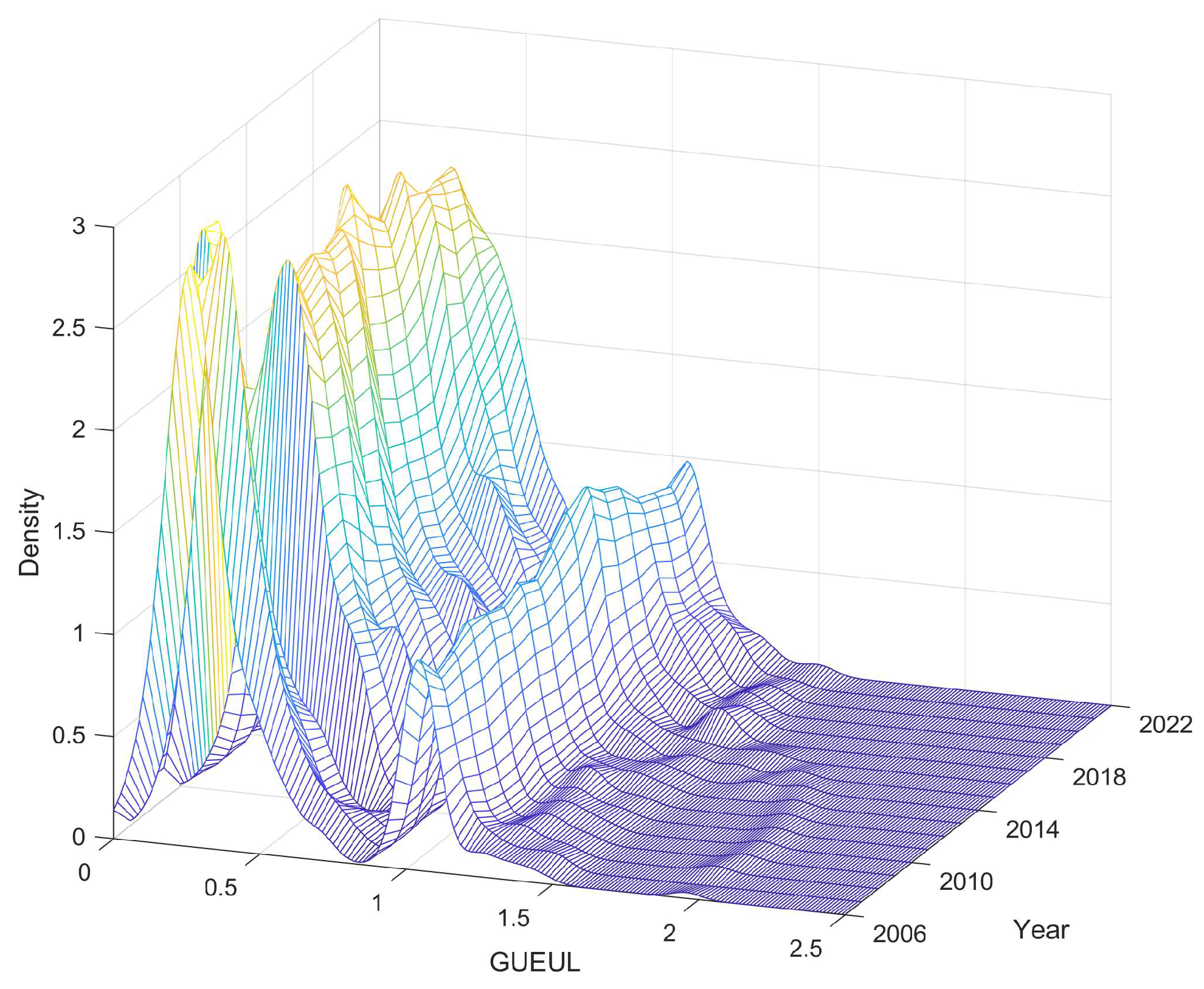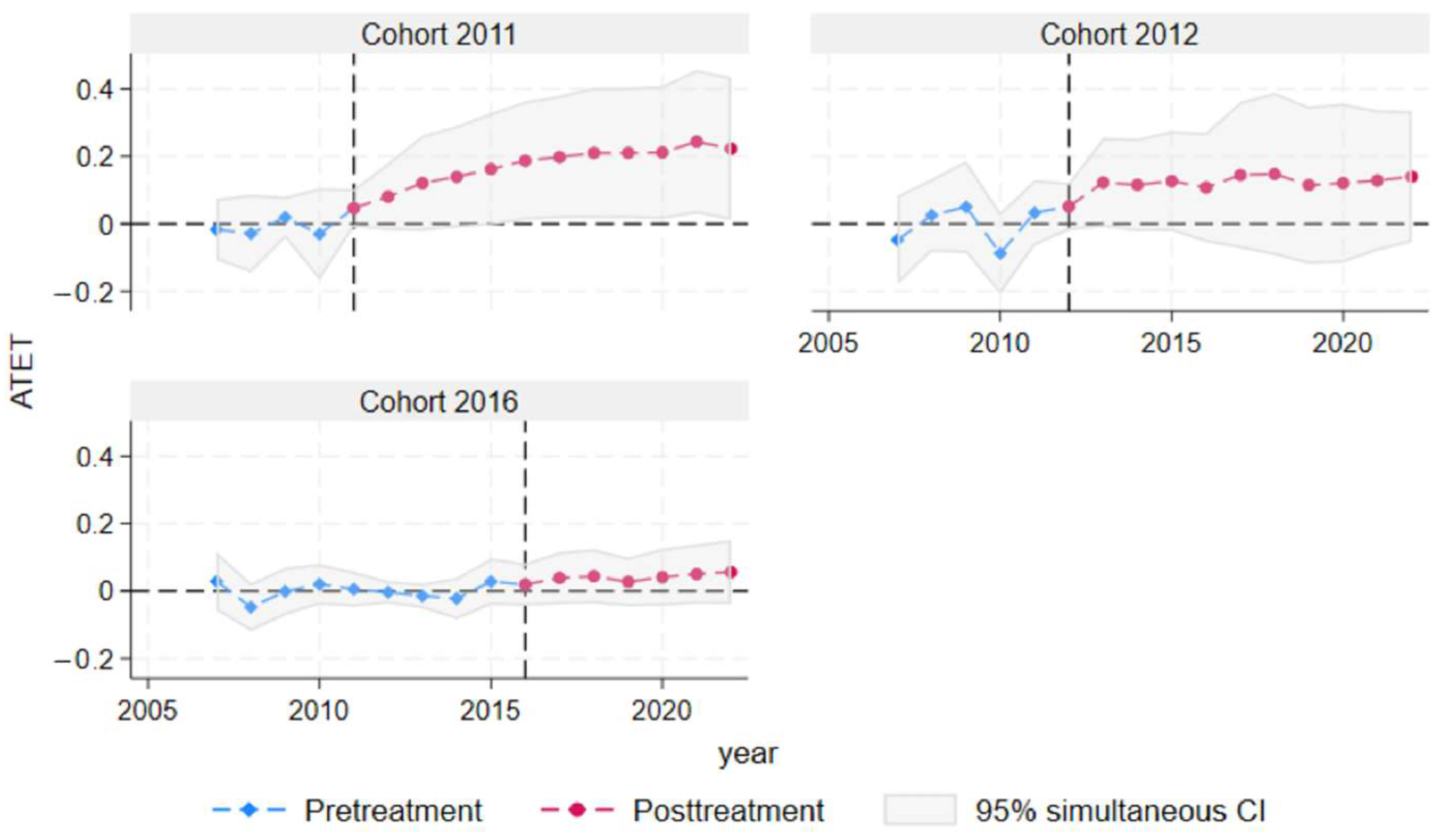1. Introduction
Land plays a pivotal role in advancing the socioeconomic development of human societies and ecological conservation, serving as a crucial material foundation for urban “production life ecology” spaces, significantly influencing various stages of economic and population growth [
1]. Looking back over history, the development of China’s urbanization process has been mind-boggling. This magnificent urbanization movement, with its overwhelming momentum, has accomplished in just over thirty years what it took western countries one or two centuries to achieve. Amazingly, China went from the end of the 1980s with a district of 17.9% of the urban population base, all the way up to 2023 with a staggering 66.61%, making it a great country in the urbanization of the road of the courage to progress (
https://www.stats.gov.cn/sj/zxfb/202402/t20240228_1947915.html), accessed on 2 February 2025. However, the share of urban built-up areas within the total land area rose from 0.07% to 0.67%. The dense population and industrial presence, coupled with restricted land availability, render the conventional extensive development model dependent on heavy industry conducive to issues such as monoculture land use, significant waste generation, and environmental deterioration. Issues related to land use efficiency and the delayed enhancement of the ecological environment in comparison to urban development are increasingly becoming apparent [
2,
3,
4]. The 2023 carbon dioxide emissions report from the IEA indicates that China’s carbon emissions reached 12.6 billion tons in 2023, reflecting an increase of 565 million tons from the prior year, accounting for over one-third of the total increase in emissions for that year (
https://www.iea.org/reports/co2-emissions-in-2023), accessed on 3 February 2025. Despite the substantial expense associated with land utilization, a paradox frequently arises between economic advancement and environmental conservation. In this context, enhancing land use efficiency is critical for the effective distribution of land resources. It represents a key strategy for establishing a sustainable development [
5].
The profound transformation of the modernization of government governance has seen a key breakthrough since the eighteenth CPC National Congress. The systematic project of “simplifying administration, delegating power, combining administration and optimizing services” has been carefully constructed, reflecting the enhancement of the wisdom of governance. This reform idea not only reflects the deep understanding of the government’s “visible hand” on the market mechanism, but also highlights its strategic planning for economic and social reform—allowing the market, the “invisible hand”, to be fully utilized, thus stimulating the vitality of institutional innovation in a broader dimension. The Outline of the Fourteenth Five-Year Plan for National Economic and Social Development (2021–2025) emphasizes the urgent need to accelerate the transition to sustainable environmental practices, optimize land use, and work to address the many chronic problems that persist in China’s land approvals—cumbersome and overlapping procedures, inefficiencies, and protracted cycles—which have led to a serious erosion of the efficiency of urban land resource allocation. As the most populous developing nation globally, China has vast land, which provides fertile fields for the experiment of land system reform. In 2011, the Ministry of Land and Resources’ announcement regarding the implementation of a pilot program aimed at enhancing the examination and approval process for urban construction land, which has been submitted to the State Council for approval (gtzf [2011] No. 57) and was officially issued, which began the prelude to the reform of land examination and approval management system, requiring the appropriate decentralization of land examination and approval authority to improve the efficiency of land allocation (as shown in
Figure 1).
As a key evaluation indicator for measuring the degree of harmony between human beings and the natural environment, the evolution of land use efficiency measurement methods has precisely demonstrated the development trajectory of increasingly rich and systematized research perspectives. Examining this change from the methodological level, it is not difficult to find that it reflects the deepening of the academic community’s knowledge of human–land relations. At the level of measurement method evolution, early studies mostly used single indicators such as unit land area and economic output to characterize [
6,
7,
8,
9]. However, this method overlooked the influence of other production factors and environmental externalities, making it challenging to precisely identify the origins of efficiency loss and ecological costs [
10]. In order to break through the above limitations, total factor productivity (TFP) analysis has been introduced into the calculation of land use efficiency, which integrates land, capital, labor, and other input factors through DEA or SFA, and regards economic output as the core index to build an input output measurement system, so as to calculate the land use efficiency of regional development more comprehensively [
11]. However, there are still “ecological blind spots” in the traditional TFP framework, which fails to incorporate negative externalities such as environmental pollution into the accounting system. With green development and ecological civilization construction becoming a national strategy, the concept of “green urban land use efficiency in Urban Land” came into being. Its core innovation is to introduce unexpected outputs such as industrial wastewater and carbon emissions into the production function. Researchers use parameter SFA [
12] or nonparametric DEA to estimate GUEUL [
13].
With the continuous emergence of new methods, scholars also realize that simple static estimation is difficult to reflect the dynamic characteristics and spatial diffusion characteristics of efficiency over time. Some researchers utilize the Thiel index, spatial autocorrelation, and the Gini coefficient to assess the degree of variation in ULUEE across different spatial dimensions [
14,
15]. However, these approaches are inadequate in articulating the transfer and alteration of ULUEE across regions. It is yet to be determined whether the alterations in GUEUL facilitate or hinder the developments in adjacent cities, and how these progress spatially [
16]. The Markov chain in the spatial dimension derives a set of subtle spatial transfer matrices, which not only reveals the complex mechanism of the spread of ulcer disease across geographic regions, but also profoundly demonstrates the intrinsic pattern of its geographic spillover effect [
17].
Through the insight of this mathematical tool, we were able to glimpse the dynamic features of ulcer disease evolution on the spatial and temporal scales, which is uniquely inspiring for understanding the disease spread pattern. In the discussion of impact mechanism, studies have pointed out that exogenous Institutional Shocks and policy interventions can significantly affect land use efficiency [
18], especially regional coordinated governance, low-carbon pilot projects, and digital governance, which can change the supply and demand pattern of urban land through factor market integration, industrial structure evolution, and infrastructure interconnection. Taking carbon trading or low-carbon pilot projects as an example, local governments often promote the transformation of industrial structures into a cleaner and higher value-added direction in the process of implementing emission reduction targets, and enhance the matching degree between resource endowment and innovation ability [
19]. A new wave of green technological innovation is profoundly reshaping the way and pattern of land resource utilization, and this change has aroused great concern in the academic community. Through in-depth analysis of the intrinsic connection between green technological innovation and land efficiency, scholars have revealed a thought-provoking phenomenon: technological innovation is not only a catalyst for the optimal allocation of land resources, but also a sharp blade for reconstructing the traditional development model. A large number of empirical studies confirm this view—in the context of low-carbon development, green technological innovations are driving land resource utilization in a more sustainable direction with unprecedented strength. This is achieved through the substitution of traditional, energy-intensive production methods and the enhancement of factor allocation efficiency. In the context of innovation-driven development, the establishment of national autonomous innovation demonstration zones has brought about a significant improvement in the efficiency of low-carbon utilization of urban land, a conclusion derived from the in-depth study by Xu et al. [
20]. Their analysis reveals the central role of the dual-wheel drive of green technological innovation and economies of scale. It is noteworthy that the benefits brought by technological innovation are not static and solidified, but show progressive and dynamic enhancement characteristics. This finding is further corroborated in the empirical study of the Yangtze River Delta urban agglomeration, which provides strong evidence for our understanding of the intrinsic link between innovation policies and environmental benefits. Yang et al. [
21] used the SBM-DEA model to confirm that the coordinated innovation of green technology, digital technology, and transportation technology in the process of urbanization increased the green land use efficiency by 0.048% by restraining energy consumption and alleviating pollution, highlighting the intermediary amplification role of technological innovation. The nonlinear model constructed by Luo and Cheng [
22] further deconstructs the nonlinear mechanism of technology land system, and its research results show that the intensification of land elements and the green development of agriculture show an inverted U-shaped relationship, in which the progress of agricultural technology effectively breaks through the locking effect of traditional extensive development by optimizing the allocation of capital and energy elements. It is important to highlight that the impact of technological innovation on enhancing land efficiency exhibits considerable heterogeneity. The Spatial Econometrics Study of Liu and Dong [
23] shows that the developed eastern regions have achieved a leap in the efficiency of green land economy through the upgrading of technology intensive industries, while the central and western regions rely more on the spatial spillover effect of innovative factors. The negative effect of land resource mismatch on green technological innovation is not fixed; Gao and other scholars [
24], through the threshold model, reveal a phenomenon worthy of deep thought: in the double driving force of rising economic development level and environmental regulation, this adverse effect will be gradually dissolved. This finding not only confirms the internal law that institutional innovation and technological progress complement each other, but also highlights the practical significance of constructing a benign interaction mechanism.
Research on the relationship between reform policies and GUEUL has predominantly explored three key areas. The first area examines the influence of macroeconomic strategies on GUEUL. Scholars like Liu et al. [
25] suggest that governments should drive land system reforms and adopt innovative strategies to navigate China’s economic transition into the “new normal”. Yuan et al. [
26] point out that the establishment of free trade zones significantly boosts GUEUL, primarily through technological innovation and industrial upgrading. The second area investigates the role of environmental regulations in enhancing GUEUL. For instance, Niu et al. [
27] demonstrate that China’s low-carbon city pilot policies improve GUEUL by directing fiscal spending towards corporate R&D and attracting high-tech talent, which fosters technological innovation and ultimately benefits GUEUL. The third area focuses on government land regulation. Wang et al. [
28] argue that China must continue to reform land policies to optimize the use of its limited land resources.
Generally speaking, the existing research has been quite rich, and GUEUL is mainly driven by economic development, scientific and technological level, and industrial structure [
29,
30,
31]. Therefore, this paper focuses on GUEUL, based on the theoretical framework of “system decentralization information utilization efficiency improvement” [
32] and on the basis of using the SBM model to measure it, investigates the impact of the pilot policy of “urban land approval system reform”, and explores the promotion role of the impact mechanism represented by institutional transaction costs and industrial agglomeration level. Throughout the practical history of land system innovation, the “overweight” chaos in the process of policy piloting has aroused widespread concern; coupled with the increasingly complex and diversified characteristics of urban environments, these factors are intertwined to form a picture worthy of deep reflection. Based on the current situation, this study reveals, through multi-dimensional analysis, how the innovation of the land system influences GUEUL with different paths and intensities. The analysis focuses on two key factors: institutional transaction costs (ITCs) and industrial agglomeration (IA). This approach seeks to address the gaps in current research and offers valuable insights for policymakers to optimize land policy, enhance governance efficiency in the evolving development stage, and foster the green transformation of land use models.
Thus, from the viewpoint of urban land utilization, does the introduction of the pilot policy for the urban construction land approval system enhance GUEUL? Should the promotional effect be confirmed, through which mechanisms might it operate? The scientific assessment and quantification of the aforementioned issues are closely tied to the evaluation, optimization, and enhancement of urban construction land approval systems and policies. This in-depth study not only improves China’s current policy system, but also provides valuable theoretical support for the rational allocation of land resources and economic transformation and upgrading. We analyzed the development trajectories of nearly 300 cities in China over the past 17 years (2006–2022), and systematically assessed how the pilot reform of the construction land use approval system affects the green utilization of urban land resources with the help of EBM-DEA modeling and fixed-effects analysis. In the course of this study, the effectiveness of the implementation of this policy is quantitatively analyzed in multiple dimensions.
This paper realizes unique academic value through multi-dimensional innovative research methods. When constructing the evaluation system, it creatively integrates carbon emissions and other pollutants as negative outputs into the GUEUL efficiency evaluation indexes, and applies the EBM-DEA model to carry out in-depth analysis of 296 prefecture-level cities nationwide, supplemented by kernel density analysis to verify the scientific rigor and reliability of the evaluation results. To further deepen the research perspective, this paper takes the pilot reform of land approval system as an entry point, and creates a quasi-natural experiment to reveal the intricate connection between land system innovation and urban land green utilization efficiency. It is noteworthy that the study also focuses on the key elements of urban development, exploring the two core dimensions of the initial level of infrastructure and land finance dependence, and revealing the deeper impact mechanism of decentralization of urban land approvals on GUEUL.
3. Study Design and Variable Selection Analysis
3.1. Model Building
Benchmark regression model. The purpose of this paper’s benchmark regression is to examine whether a region’s experience of land system innovation will affect GUEUL. Considering the regional and temporal differences in the reform policy of land approval authority, this paper regards the reform of land approval authority launched in 2011, 2012, and 2016 as a quasi-natural experiment, and constructs the following incremental dual difference model to test:
In Equation (1), is for GUEUL; is the interaction item between the virtual variable of the starting time of the reform of land approval power and the virtual variable of the pilot city. Its coefficient focuses on parameters for this article, used to capture the impact of the reform of land approval authority on GUEUL; is the intercept term; is the set of control variables, is the corresponding coefficient; and are individual and time-fixed effects, respectively; is the random disturbance term.
3.2. Testing Methods
(1) Nuclear density estimation. Kernel density estimation stands out as a superior analytical tool for characterizing the distribution of GUEUL efficiency data. This method has the unique advantage of presenting the distributional pattern of the data in the best possible way by generating a smooth and continuous density profile. In the perspective of mathematical modeling, when we define the density function of X as
, its density function value can be approximated with the help of a subtle system of formulas:
where
is the kernel density function,
Indicates the efficiency value of GUEUL;
represents the average value of X, and n represents the number of prefecture-level cities in the study area;
is the bandwidth, and (·) is the kernel function.
(2) Parallel trend test. The scientific validity of the policy impact assessment is highly dependent on the rigorous testing of a key prerequisite: whether the GUEUL indicators for the treatment and control groups exhibited statistically significant homogeneity before the pilot urban reform program was put into practice, which is particularly important for the validation of the parallel trend hypothesis. Given that the demonstration area is developed in phases, this study employs the event study approach, as outlined in Formula (3), to examine the parallel trend. is a virtual variable and represents the No. questionnaire period in front of the window of “reform of urban land approval authority”, represents the estimate for each period.
Among them, represents a series of dummy variables. A closer look at the screening criteria of the pilot area for decentralization of land approval in City “” shows that the K-value is quantitatively defined as 1 whenever the time point falls within the observation window of “” years prior to the formulation of the policy, or within the monitoring interval of “” years after the policy, while the K-value is reset to zero for any time period that falls outside of these two key time points.
(3) Placebo test. Another issue in evaluating the impact of establishing “reform” pilot cities on GUEUL using the difference-in-differences model is that the observed conclusions might merely be the result of coincidence. This paper employs a random placebo test, primarily to examine whether the estimation results are caused by the policy effect. Therefore, to eliminate potential randomness in the benchmark regression results, a random placebo test is adopted. If the policy estimation in the fictional scenario remains significant, the original estimation might be biased, and the changes in the explanatory variable GUEUL could be influenced by other policy implementations or random factors. Specifically, in each random sampling, one year is randomly selected from each of the 296 sample cities, and then 75 cities are randomly chosen as the virtual treatment group, with any year within the sample period randomly determined as the establishment time of the “reform” pilot cities. The above extraction steps and benchmark regression are repeated 500 times.
(4) Counterfactual test. Before the initiation of the demonstration zone construction, China had implemented regional transformation and industrial upgrading policies for many years, including the “National Sustainable Development Plan for Resource-Based Cities (2013–2020)” and the “National Adjustment and Transformation Plan for Old Industrial Bases (2013–2022)”. These policies proposed numerous goals and requirements for optimizing economic structure adjustment and enhancing industrial competitiveness. The implementation of these policies not only served as the foundation for the construction of the demonstration zone but also potentially had an earlier impact on GUEUL. To this end, relevant scholars gathered research ideas and advanced the construction timeline of the demonstration zone year by year to conduct a reverse verification of the facts. By constructing “counterfactuals” to simulate possible outcomes under different conditions, this study aimed to determine the true impact of a certain treatment or intervention on the target variable.
(5) PSM-DID. To mitigate pre-existing differences, propensity score matching (PSM) was applied to the samples before group assignment. The core idea is to match the treatment group and the control group by calculating the propensity score, which is the probability of an individual receiving treatment. Specifically, during the research period, all cities designated as demonstration cities were classified as the treatment group, while the control variables served as the reference. A step-by-step matching method was adopted to select city samples with similar characteristics to the demonstration cities, thereby reducing estimation bias caused by differences in individual characteristics. Subsequently, tests were conducted based on the baseline model.
(6) Excluding other policy implications. In addition to the policies studied in this research, there are other significant policy interventions or exogenous shocks. These changes may affect the differences between the treatment group and the control group, thereby influencing the causal interpretation of the DID. So, to account for the potential influence of other concurrent initiatives on GUEUL during the pilot program, this research factors in dummy variables that represent both the “low-carbon cities” and the launch of “zero-waste cities” into the standard regression model used as a starting point for analysis [
44,
45].
(7) HTE-DID. To evaluate the resilience of the initial regression results, this study employs the Heterogeneous Treatment Effect Difference-in-Differences (HTE-DID) method as a robustness check. Drawing on the Group-Time ATT framework developed by Callaway & Sant’Anna [
46], this approach effectively isolates causal effects for individuals treated at varying points in time, addressing the estimation biases that plague traditional DID methods in staggered adoption scenarios. Unlike standard DID, HTE-DID accounts for variations in treatment effects across individuals and time periods, offering a more nuanced analysis.
3.3. Variable Description
(1) Explanatory variable: Land system innovation (LII). The time nodes of the implementation of the pilot urban construction land use approval system reform policy are embedded in a mathematical model, and the policy effect is captured by constructing a double-difference interaction term between the pilot cities and the time dimension. In the model setting, for any city I, its LSI value turns to 1 when it enters the year of the pilot sequence, while the LSI value remains at 0 for the cities that are not included in the pilot before that time. This way of treatment can not only accurately identify the spatial and temporal distribution of policy effects, but also effectively avoid the influence of various disturbing factors.
(2) Explained variable: GUEUL. The urban land use efficiency evaluation system analyzes in depth the input–output relationship of production factors in a specific technological environment, and systematically considers land as a core factor. This evaluation system is not limited to the traditional economic output perspective, but includes environmental benefits in the assessment, especially focusing on the ecological benefits and greening level in the process of land use. Based on the research foundation of existing literature [
47], the system constructs a multi-dimensional evaluation framework, covering key dimensions such as input elements, expected benefits, and unintended outputs. By introducing the innovative EBM-DEA model, the indicators including unintended outputs are quantitatively analyzed and comprehensively evaluated.
Figure 3 visualizes the internal logical structure and specific connotation of the indicator system.
(3) Intermediary variables: ① institutional transaction cost (ITC). The existing literature is mostly measured by government non tax income/government income; ② At present, some studies use economic density to measure the degree of industrial agglomeration (IA) [
48], but economic density cannot reflect many cities with high economic vitality and a developed service industry. By implementing the methodological tool of geographical entropy, this study was able to more accurately grasp the distributional characteristics of the manufacturing aggregation phenomenon in its assessment. The unique advantage demonstrated by this assessment approach lies in its ability to portray the spatial distribution of regional elements, especially in dissolving the interference brought about by regional scale differences, which demonstrates a convincing explanatory power. It is worth mentioning that the adoption of this assessment tool forms a good academic dialog with existing studies [
49].
(4) Control variables: Based on existing literature and relevant theories, Hu and Wang used LnGDP as a control variable in their study examining the effects of industrial migration on industrial land use efficiency in China [
50]. Other researchers have also incorporated various dimensions such as population, economy, finance, and technology in their studies [
51,
52,
53]. Accordingly, this paper selects five key variables to account for potential confounding factors: first, urban population density (PD), measured as the number of people per unit area, which indicates population distribution and the extent of urban land use; second, foreign direct investment (FDI), measured by the ratio of foreign direct investment to GDP, which reflects the inflow of external capital and its influence on GUEUL; third, financial development efficiency (EFD), represented by the year-end bank deposit-to-loan ratio, which signifies the efficiency and maturity of the regional financial market; fourth, scientific development level (SD), defined as the proportion of urban science and technology expenditure to GDP, which indicates regional innovation capability and technological progress; fifth, economic development level (LnPGDP), expressed as the logarithm of GDP per capita, which represents the fundamental economic condition.
3.4. Study Area Overview and Data Description
Facing the deep-seated reform in the field of urban construction land use approval in China, this study selects 296 prefecture-level cities as a sample to explore the complex impacts of institutional changes on GUEUL. In this powerful wave of reforms, the Ministry of Land and Resources (MLR) approved 107 prefectural-level cities as pilot cities in 2011, 2012, and 2016 to carry out an unprecedented experiment in institutional innovation. These cities, like reform pioneers, are leading the future direction of China’s urban development through practical exploration. At the same time, the other 189 prefectural-level cities acted as a control group, silently witnessing the far-reaching impact of this institutional change. In our opinion, this pilot-control research design reveals the effectiveness of the reform and provides us with a unique perspective on urban development.
With the awakening of the awareness of environmental protection, the State Council elevated the construction of a “resource-saving and environmentally friendly society” to the level of national strategy in 2005, and this decision was further implemented in the following year. In 2006, China explicitly set the goal of energy conservation and emission reduction, and took environmental protection as an important factor for economic growth, which marked a major transition in China’s environment and development policies. Building upon this historical context and drawing on relevant literature, this study extends the research period both forward and backward by five years to comprehensively examine the dynamic changes before and after the reform. Consequently, the final study period is set from 2006 to 2022, allowing for an in-depth analysis of the developmental characteristics during this transitional phase [
54,
55,
56].
The data system required for this study covers multiple dimensions: the data related to the pilot cities of the urban construction land use approval system reform come from the Ministry of Land and Resources; other key indicators are integrated from authoritative literature such as the China Urban Statistical Yearbook, the Statistical Bulletin of National Economic and Social Development, and the China Urban Construction Statistical Yearbook. In order to ensure the comparability and accuracy of the data, we adjusted the price variables with 2006 as the base year, and for the missing data in individual years, the linear interpolation method was used to make reasonable estimates.
Table 1 presents the descriptive statistics of the relevant variables.
